Single- and Two-Phase Flow Characterization Using Optical Fiber Bragg Gratings
Abstract
:1. Introduction
2. Sensor Unit and Experimental Setup
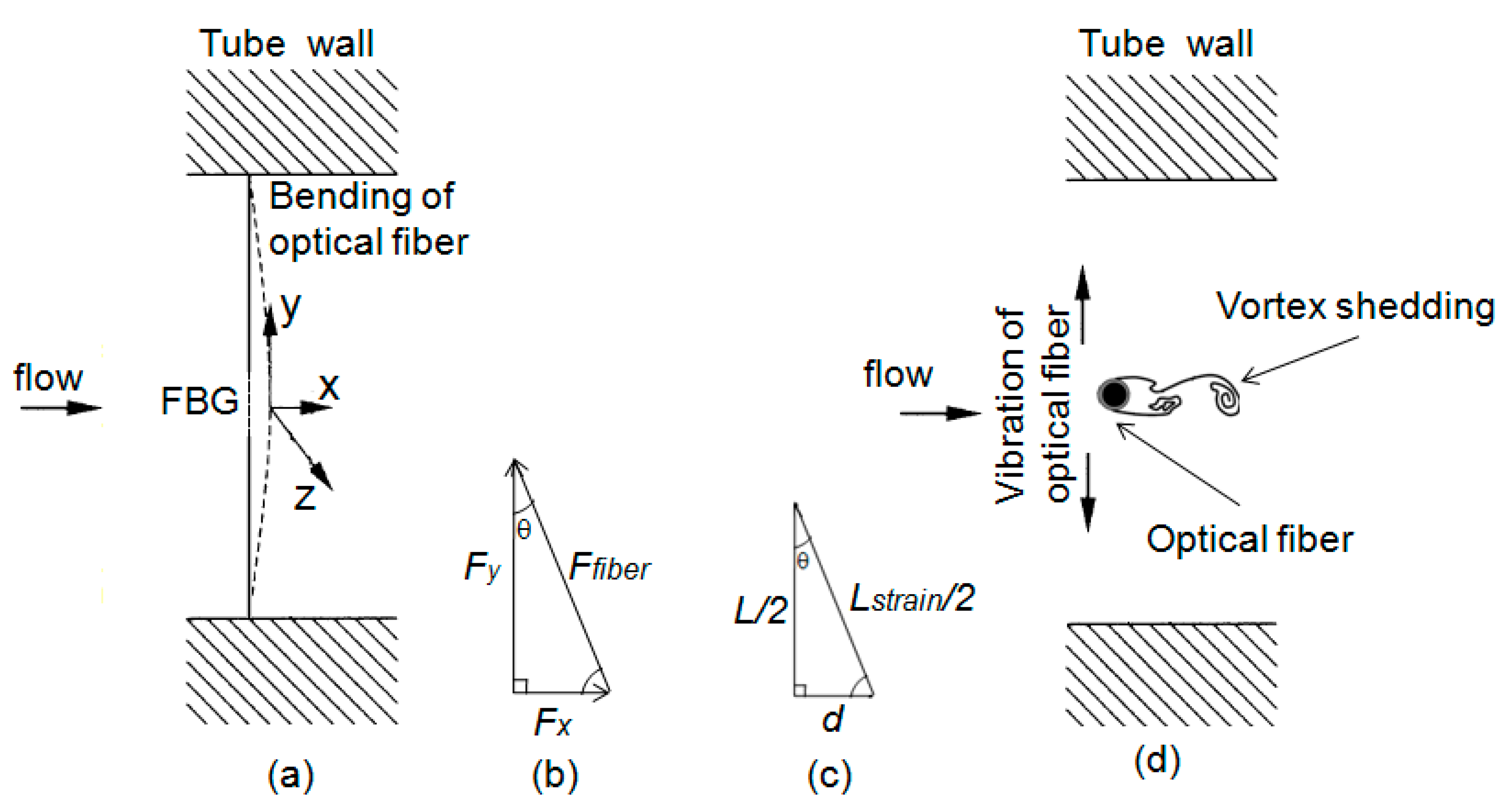
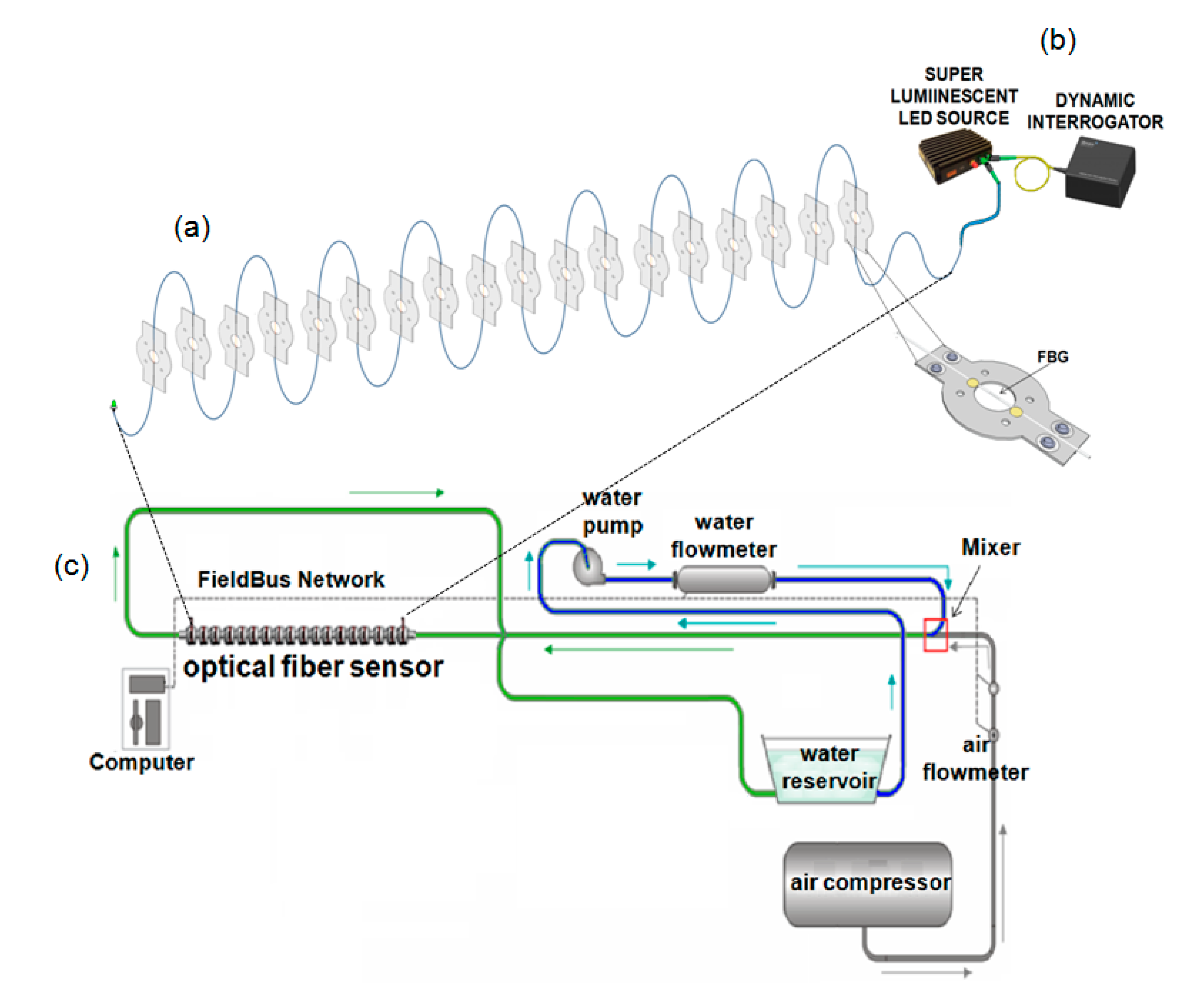
3. Results and Discussion
3.1. Single-Phase Flow Measurements
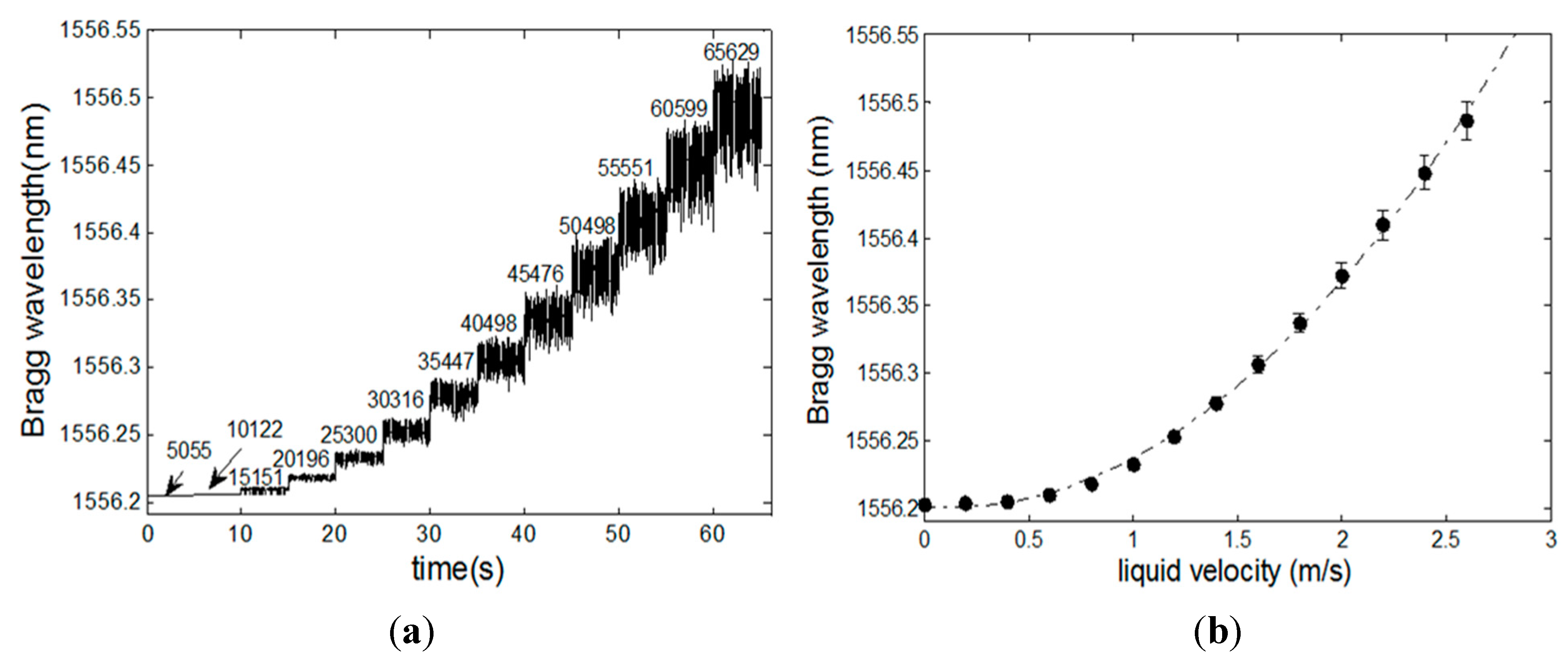

3.2. Two-Phase Flow Measurements
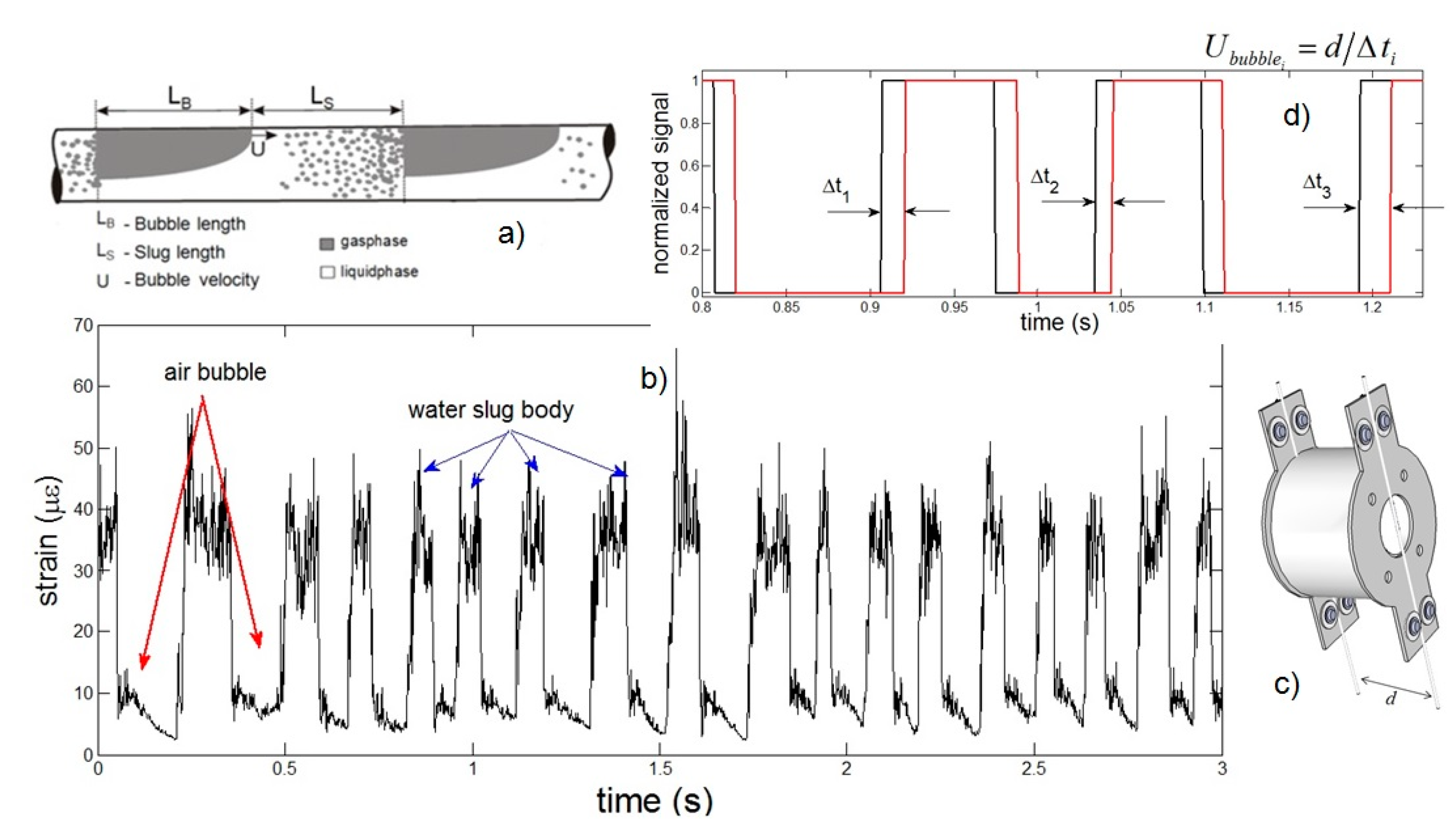
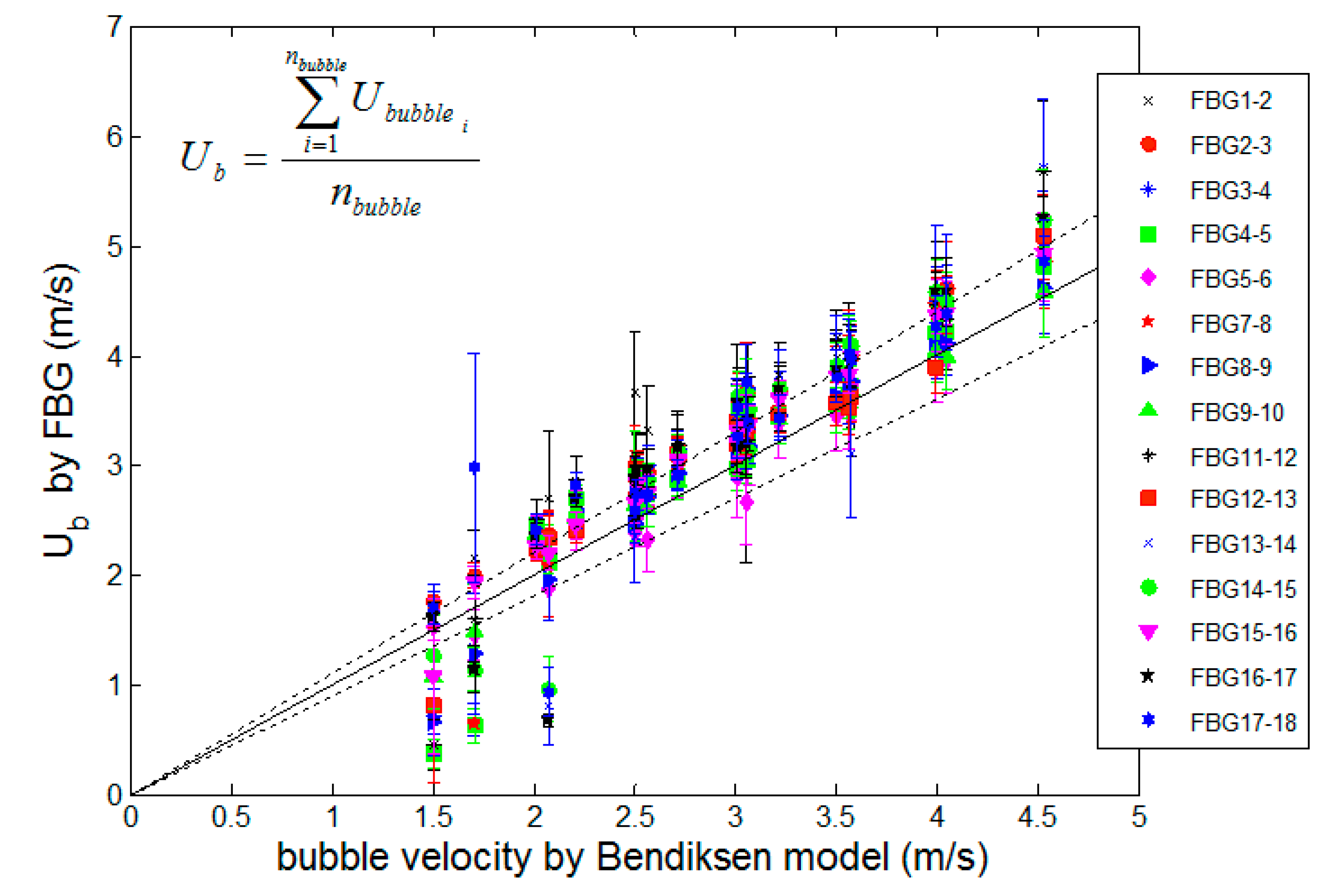
4. Conclusions
Acknowledgments
Author Contributions
Conflicts of Interest
References
- Azzopardi, B. Gas-Liquid Flows; Begell House: New York, NY, USA, 2006. [Google Scholar]
- Da Silva, M.J.; Schleicher, E.; Hampel, U. Capacitance wire-mesh sensor for fast measurement of phase fraction distributions. Meas. Sci. Technol. 2007, 18, 2245–2251. [Google Scholar]
- Johansen, G.A. Nuclear tomography methods in industry. Nuclear Phys. A 2005, 752, 696–705. [Google Scholar] [CrossRef]
- Hassan, Y.A. Multiphase bubbly flow visualization using particle image velocimetry. Ann. N. Y. Acad. Sci. 2002, 972, 223–228. [Google Scholar] [CrossRef] [PubMed]
- Da Silva, M.J.; Thiele, S.; Abdulkareem, L.; Azzopardi, B.J.; Hampel, U. High gas-oil two flow visualization with a capacitance wire-mesh sensor. Flow Meas. Instrum. 2010, 21, 191–197. [Google Scholar]
- Kersey, A.; Davis, M.; Patrick, H.; LeBlanc, M.; Koo, K.P.; Putnam, M.; Firebele, E. Fiber grating sensors. J. Lightwave Technol. 1997, 15, 1442–1463. [Google Scholar] [CrossRef]
- Cheng, S.; Zhang, Y. Application of Fiber grating sensor for oil leak detection in oil industry. Appl. Opt. 2008, 29, 441–443. [Google Scholar]
- Hassan, M.; Tamchek, N.; Abas, A.; Johar, R.; Adikan, F. Dual-phase sensing for early detection of prepreg structural failures via etched cladding Bragg grating. Sens. Actuator A Phys. 2011, 171, 126–130. [Google Scholar] [CrossRef]
- Schizas, C.; Stutz, S.; Botsis, J.; Coric, D. Monitoring of non-homogeneous strains in composites with embedded wavelenght multiplexed fiber Bragg gratings: A methodological study. Compos. Struct. 2012, 94, 987–994. [Google Scholar] [CrossRef]
- Zhao, Yo.; Zhao, Ya.; Zhao, M. Novel force sensor based on a couple of fiber Bragg gratings. Measurement 2005, 38, 30–33. [Google Scholar] [CrossRef]
- Urban, F.K.J.; Vlach, R.; Kuchta, R. Design of a pressure sensor based on optical fiber Bragg grating lateral deformation. Sensors 2010, 10, 11212–11225. [Google Scholar] [CrossRef] [PubMed]
- Ng, J.; Zhou, X.; Ang, X.Y.; Hao, J. A simple temperature-insensitive fiber Bragg grating displacement sensor. Opt. Commun. 2007, 273, 398–401. [Google Scholar] [CrossRef]
- Zhan, Y.; Xue, S.; Yang, Q.; Xiang, S.; He, H.; Zhu, R. A novel fiber Bragg grating high-temperature sensor. Optik 2008, 119, 535–539. [Google Scholar] [CrossRef]
- Yeo, T.; Sun, T.; Grattan, K.; Parry, D.; Lade, R.; Rowell, B.D. Characterisation of polymer-coated fibre Bragg grating sensor for relative humidity sensing. Sens. Actuator B Chem. 2005, 110, 148–156. [Google Scholar] [CrossRef]
- Fernandez, A.; Brichard, B.; Berghmans, F.; Decreton, M. Dose-rate dependencies in gamma-irradiated fiber Bragg grating filters. IEEE Trans. Nucl. Sci. 2002, 49, 2874–2878. [Google Scholar] [CrossRef]
- Barton, J.S.; Saoudi, M. A fiber optic vortex flowmeter. J. Phys. E Sci. Instrum. 1986, 19, 64–66. [Google Scholar] [CrossRef]
- Takashima, S.; Asanuma, H.; Niitsuma, H. A water flowmeter using dual fiber Bragg grating sensors and cross-correlation technique. Sens. Actuators A Phys. 2004, 116, 66–74. [Google Scholar] [CrossRef]
- Zhao, Y.; Chen, K.; Yang, J. Novel target type flowmeter based on a differential fiber Bragg grating sensor. Measurement 2005, 38, 230–235. [Google Scholar] [CrossRef]
- Nigel, D.; Djilali, N.; Wild, P. Fiber Bragg grating sensor for two-phase flow in microchannels. Microfluid. Nanofluid. 2012, 13, 99–106. [Google Scholar] [CrossRef]
- Lu, P.; Chen, Q. Fiber Bragg grating sensor for simultaneous measurement of flow rate and direction. Meas. Sci. Technol. 2008, 19. [Google Scholar] [CrossRef]
- Wang, X.; Dong, X.; Zhou, Y.; Li, Y.; Cheng, J.; Chen, Z. Optical fiber anemometer using silver-coated fiber Bragg grating and bitaper. Sens. Actuators A Phys. 2014, 214, 230–233. [Google Scholar] [CrossRef]
- Othonos, A. Fiber Bragg gratings Fundamentals and Applications in telecommunications and Sensing; Artech House, Inc.: Norwood, MA, USA, 1999. [Google Scholar]
- Bendiksen, K.H. An experimental investigation of the motion of long bubbles in inclined tubes. Multiph. Flow 1984, 10, 467–483. [Google Scholar] [CrossRef]
© 2015 by the authors; licensee MDPI, Basel, Switzerland. This article is an open access article distributed under the terms and conditions of the Creative Commons Attribution license (http://creativecommons.org/licenses/by/4.0/).
Share and Cite
Baroncini, V.H.V.; Martelli, C.; Da Silva, M.J.; Morales, R.E.M. Single- and Two-Phase Flow Characterization Using Optical Fiber Bragg Gratings. Sensors 2015, 15, 6549-6559. https://doi.org/10.3390/s150306549
Baroncini VHV, Martelli C, Da Silva MJ, Morales REM. Single- and Two-Phase Flow Characterization Using Optical Fiber Bragg Gratings. Sensors. 2015; 15(3):6549-6559. https://doi.org/10.3390/s150306549
Chicago/Turabian StyleBaroncini, Virgínia H.V., Cicero Martelli, Marco José Da Silva, and Rigoberto E.M. Morales. 2015. "Single- and Two-Phase Flow Characterization Using Optical Fiber Bragg Gratings" Sensors 15, no. 3: 6549-6559. https://doi.org/10.3390/s150306549
APA StyleBaroncini, V. H. V., Martelli, C., Da Silva, M. J., & Morales, R. E. M. (2015). Single- and Two-Phase Flow Characterization Using Optical Fiber Bragg Gratings. Sensors, 15(3), 6549-6559. https://doi.org/10.3390/s150306549





